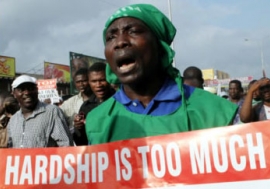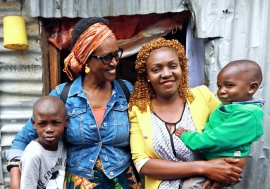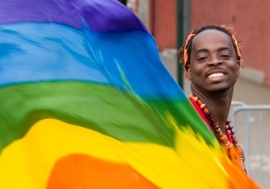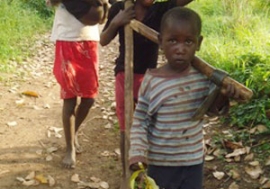African AIDS battle at a crossroads
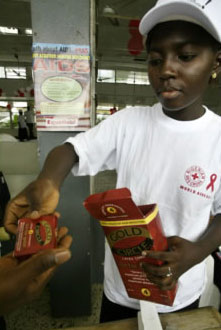 Condom distribution in Nigeria: AIDS prevention programmes are beginning to have an impact.
Condom distribution in Nigeria: AIDS prevention programmes are beginning to have an impact.A quarter of a century after the first AIDS cases were diagnosed, a handful of countries in Africa and elsewhere are showing that determined efforts to combat the disease can succeed in lowering infection rates. In Kenya and Zimbabwe, and in urban areas in a few other countries, the percentage of people infected with the HIV virus that causes AIDS was below the levels recorded two years earlier.
“The global AIDS response stands at a crossroads,” UN Secretary-General Kofi Annan reported to a special high-level meeting of the General Assembly on 31 May–2 June. The road to success will entail building on the recent progress, Mr. Annan stated, with “unprecedented” efforts to strengthen national anti-AIDS policies and provide much wider access to treatment and prevention programmes. But failure to pursue such a course would allow the pandemic to spread further, at the cost of many more lives. “Countries whose development is already flagging because of AIDS will continue to weaken, potentially threatening social stability and national security.”
African delegates agreed strongly with that assessment. “We need to do much more if we are to reverse and indeed to end this pandemic,” Zambian Minister of Foreign Affairs Ronnie Shikapwasha told the meeting. And despite some signs of progress, he reminded the participants, “each life lost due to AIDS marks a milestone defeat in our fight against AIDS.”
At the close of the three-day meeting, the delegates vowed a greatly stepped-up battle. They pledged to combine prevention, care and treatment efforts, strengthen national strategies and eliminate gender inequalities, among other steps. The representatives noted UN estimates that funding for AIDS programmes will need to be tripled over the next five years, from $8.3 bn from all sources in 2005 to $20-23 bn by 2010, and committed themselves to ensuring that “new and additional resources” are made available from both donors and affected countries.
‘Rage against women’s oppression’
The pain and urgency of those living with HIV was conveyed directly to the diplomatic representatives by Ms. Nkhensani Mavasa, deputy chairperson of South Africa’s non-governmental Treatment Action Campaign. She was the first HIV-positive person to ever address a plenary session of the General Assembly. Reporting that she herself had suffered rape and arguing that sexual abuse leaves women especially vulnerable to infection, Ms. Mavasa observed that women constitute nearly 60 per cent of the more than 40 million HIV-positive people in the world. This reality, she said, “must make us rage against women’s oppression.”
In the past, Ms. Mavasa said, political leaders hesitated, debated endlessly and failed to protect the most vulnerable, while the epidemic spread ever wider. Turning specifically to the delegates from her own continent, she added, “I call on African leaders sitting here to protect and promote the human rights of all people and vulnerable groups, particularly women and girls. We ask that you not fail us yet again.”
Signs of hope
Just before the meeting, the Joint UN Programme on HIV/AIDS (UNAIDS) issued a comprehensive report on the global AIDS epidemic. It highlighted a decline in new HIV infections in several countries. Based on the most extensive national survey data ever compiled on HIV/AIDS, the report revealed that AIDS prevention programmes are beginning to have an impact. Summarizing the findings, UNAIDS Executive Director Peter Piot said that “2005 was the least bad year in the history of the AIDS epidemic.”
In Zimbabwe, which is among the countries with the highest infection rates in Africa, the HIV prevalence rate among adults (aged 15–49) fell from 22.1 per cent in 2003 to 20.1 per cent in 2005. The report confirmed earlier indications that education and prevention programmes were contributing to behavioural changes among young Zimbabweans, who are waiting longer to become sexually active, have fewer casual sex partners and are using condoms more frequently (see Africa Renewal, January 2006).
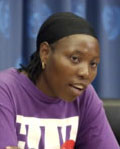 Nkhensani Mavasa, South African AIDS activist:
Nkhensani Mavasa, South African AIDS activist:“A new global response to the AIDS epidemic must build on what we have done and learned.”
Kenya also saw its HIV prevalence rate decline, from 6.8 per cent to 6.1 per cent over the same period. Burkina Faso’s national infection rate, already at a relatively low 2.1 per cent in 2003, stayed about the same. But the infection rate among 15-24 year old pregnant women in the capital fell to 1.8 per cent in 2005, compared with 3.3 per cent in 2002. Moreover, reported UNAIDS, the prevalence rate has been falling in Burkina Faso’s urban areas overall, as it has in Ethiopia and Rwanda and in the capital of Burundi.
The UN Secretary-General, in his report, noted that there also has been progress in anti-AIDS efforts globally. Between 2001 and 2005, Mr. Annan reported, total financing for HIV programmes in developing countries increased more than fourfold. The number of people on antiretroviral therapy rose fivefold, with a similar increase in the numbers of people seeking to test their HIV status.
No time to relax
“Yet the epidemic continues to outpace the global response,” Mr. Annan added. The year 2005 brought more new infections than ever before. Another 2.8 million people died of AIDS, some 2 million of them in sub-Saharan Africa.
Mr. Piot cautioned that the slowing in the rise in overall infection rates does not yet mark a turning point. “The actual number of people infected continues to rise because of population growth,” he pointed out, while in most countries of Southern African — the epicentre of the disease — very high prevalence rates are continuing to edge upwards.
At a special summit of the African Union on 2-4 May in Nigeria, African leaders recommitted themselves to fight against the epidemic, which remains “a state of emergency in our continent.” Given Africa’s own limited resources, they called on the international community to provide greater financial and technical assistance. But the African heads of state also vowed to “intensify our practical leadership role” by mobilizing local resources, strengthening African health systems, combating stigma and gender discrimination, expanding access to antiretroviral therapies and investing heavily in prevention measures. Prevention programmes, they said, should focus especially on young people, women, girls and other vulnerable groups and aim towards ensuring “universal access to male and female condoms for all sexually active persons.”
Ms. Mavasa, the South African AIDS activist, agreed with the UN and the African Union that “a new global response to the AIDS epidemic must build on what we have done and learned.” Success, she stressed, can only be achieved with “100 per cent of truth, leadership, accountability and universal access to prevention, care, treatment and support.”










